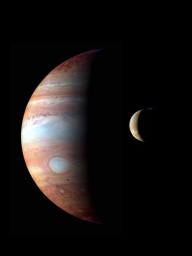
|
Jupiter-Io Montage
- Click the image above for a larger view
- Full-Res JPEG (2700 x 3600) (232.7 kB)
- Full-Res TIFF (2700 x 3600) (29.2 MB)
Caption:
This is a montage of New Horizons images of Jupiter and its volcanic moon Io, taken during the spacecraft's Jupiter flyby in early 2007. The Jupiter image is an infrared color composite taken by the spacecraft's near-infrared imaging spectrometer, the Linear Etalon Imaging Spectral Array (LEISA) at 1:40 UT on Feb. 28, 2007. The infrared wavelengths used (red: 1.59 μm, green: 1.94 μm, blue: 1.85 μm) highlight variations in the altitude of the Jovian cloud tops, with blue denoting high-altitude clouds and hazes, and red indicating deeper clouds. The prominent bluish-white oval is the Great Red Spot. The observation was made at a solar phase angle of 75 degrees but has been projected onto a crescent to remove distortion caused by Jupiter's rotation during the scan. The Io image, taken at 00:25 UT on March 1st 2007, is an approximately true-color composite taken by the panchromatic Long-Range Reconnaissance Imager (LORRI), with color information provided by the 0.5 μm ("blue") and 0.9 μm ("methane") channels of the Multispectral Visible Imaging Camera (MVIC). The image shows a major eruption in progress on Io's night side, at the northern volcano Tvashtar. Incandescent lava glows red beneath a 330-kilometer high volcanic plume, whose uppermost portions are illuminated by sunlight. The plume appears blue due to scattering of light by small particles in the plume
This montage appears on the cover of the Oct. 12, 2007, issue of Science magazine.
Cataloging Keywords:
| Name | Value | Additional Values |
|---|---|---|
| Target | Io | Jupiter |
| System | Jupiter | |
| Target Type | Satellite | Planet |
| Mission | New Horizons | |
| Instrument Host | New Horizons | |
| Host Type | Flyby Spacecraft | |
| Instrument | Linear Etalon Imaging Spectral Array (LEISA) | Long Range Reconnaissance Imager (LORRI), Multispectral Visible Imaging Camera (MVIC) |
| Detector | ||
| Extra Keywords | Atmosphere, Color, Haze, Infrared, Methane, Plume, Rotation, Storm, Visual, Volcano | |
| Acquisition Date | ||
| Release Date | 2007-10-09 | |
| Date in Caption | 2007-02-28 | 2007-10-12 |
| Image Credit | NASA/Johns Hopkins University Applied Physics Laboratory/Southwest Research Institute/Goddard Space Flight Center | |
| Source | photojournal.jpl.nasa.gov/catalog/PIA10102 | |
| Identifier | PIA10102 | |
